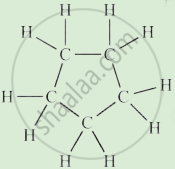Advertisements
Advertisements
प्रश्न
Taking hydrogen chloride and methane as examples, distinguish between a polar covalent bond and a non polar covalent bond.
उत्तर
Hydrogen chloride has a polar covalent bond because in hydrogen chloride the higher electronegativity of chlorine atom attracts the shared electron pair towards itself. As a result, the chlorine atom gets a partial negative charge while the hydrogen atom gets a partial positive charge. Hence such a covalent bond with charge separation is called polar covalent bond.
While methane has a non polar covalent bond because in case of methane molecule the shared electron pairs are at equal distance from the carbon and hydrogen atoms, because neither the carbon atom nor the hydrogen atom has enough electronegativity difference between each other to attract the shared pairs of electrons towards itself. Hence no charge separation occurs in the covalent bond due to which it is called non polar covalent bond.
Concept Insight: When a covalent bond is formed between the atoms of the same elements of equal electronegativity then the electron pairs are shared equally between the atoms and the bond so formed is called non polar covalent bond. On the other hand, if the covalent bond is formed between atoms of different elements, with difference in electro negativity, the electrons are not shared equally between the atoms. The more electronegative atom pulls the bonded pair of electrons towards itself and acquires negative charge while the other less electro negative atom acquires positive charge and the bond becomes polar covalent bond.
APPEARS IN
संबंधित प्रश्न
What would be the electron dot structure of carbon dioxide which has the formula CO2?
Name a carbon containing molecule which has two double bonds.
What type of bonds are present in water molecule? Draw the electron-dot structure of water (H2O).
Explain why covalent compounds have generally high melting points?
Molecular formula of Propane is C3H8 , write the structural formula of propane.
What is the difference between a polar covalent compound and a non-polar covalent compound?
Explain the following:
Polar covalent compounds conduct electricity?
Complete the following activity.
Write the names of the hydrocarbons for the following structural formula.
(isobutylene, cyclohexane, propene, cyclohexene, cyclopentane, benzene, propyne, isobutane, propane)
 |
The number of pi-bonds present in benzoic acid molecule are ______.
What is a covalent bond?
